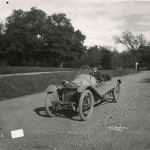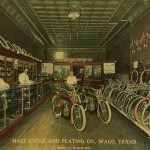If you have lived in Texas for any amount of time, you’ve experienced a tornado watch, and maybe even a tornado warning. The TV program you were watching is interrupted with dire weather maps, the radio DJ advises folks out in their cars to take shelter, the whole family huddles up in the bathtub—it’s all a little scary, especially when the sirens start to go off. And if you think your town is immune to tornados—as Huaco Native American legend said about Waco—well, an actual F5 storm striking your town is downright terrifying.

Harry Gillett’s letter to his mother, started on May 11, 1953, and continued the next day, brings to life that experience of waiting for the Waco tornado and then witnessing its aftermath. Sent home early from the school where he taught, Gillett put pen to paper to describe the storm as it escalated. First he writes of a driving rain, and then of hailstones the size of half dollars. “It has gotten so dark outside that it is practically night and it is only about 4:25.”
Then the hailstones increase to the size of baseballs, and one breaks a shingle of his roof. His father calls and tells him the hail downtown is the size of his fist. The phone lines go down shortly after their conversation. “I have never seen anything like this before. No telling how much damage will be done. There go the lights.”
How much damage will be done, indeed. In the next paragraph, Gillett writes, “I am continuing this letter at 5:00 the morning after I started writing it. Waco had the most horrible storm you can imagine.” The tornado entered the Waco city limits at 4:32 pm, and the funnel cloud was downtown by 4:36. Gillett’s North Waco home is unscathed, apart from the broken shingle. He’s lucky. His letter describes the damage done to the homes of relatives and friends—from a flooded home to a house blown off its foundation, moved a few feet, and “simply ruined.”

But other parts of Waco saw much greater devastation. Some houses were blown to bits. Gillett’s school in East Waco was destroyed, with his classroom the only one left standing on the top floor. And in downtown Waco, the toll, both property and human, was enormous. “R.T. Dennis [building] fell in completely and most of the buildings from there to the river were completely blown apart. Hundreds of people were killed…Downtown Waco has been put under martial law and Daddy will not be able to get to work. Many gas lines are broken down town and everyone is afraid of a terrible explosion.”
The Waco tornado is tied with the 1902 Goliad tornado as the deadliest in Texas history, and is one of the most deadly in US history. 114 people were killed, and property damage was in excess of $50 million—with inflation, that would be about $400 million today. The Waco tornado helped incite the development of a nationwide severe weather warning system. On this week of the 59th year since the tornado, we remember those who were lost.
You can read the complete letter at The Texas Collection in the Harry Gillett papers. Gillett also saved a few postcards depicting the 1953 tornado’s impact, which we’ve featured in the slide show below. If you’re interested in reading, watching, or listening to more accounts of the storm, check out Waco Tornado 1953: Force that Changed the Face of Waco (an oral history project by the Waco-McLennan County Library and the Baylor Institute for Oral History), “Living Stories: Radio and the 1953 Waco Tornado,” a collaboration of the Institute for Oral History and KWBU-FM, and the “Waco Tornado: Tragedy and Triumph” video at the Texas Archive of the Moving Image. The Portal to Texas History and Waco Tribune-Herald also have compelling images and contemporary news coverage of the storm.


























